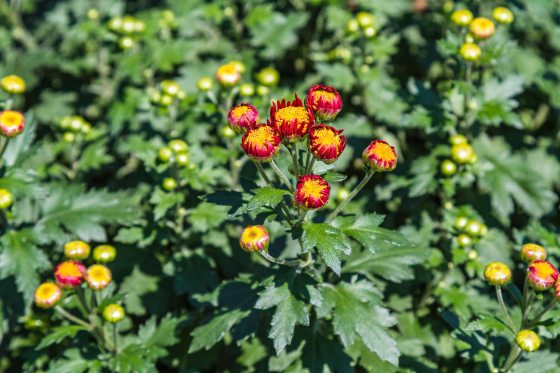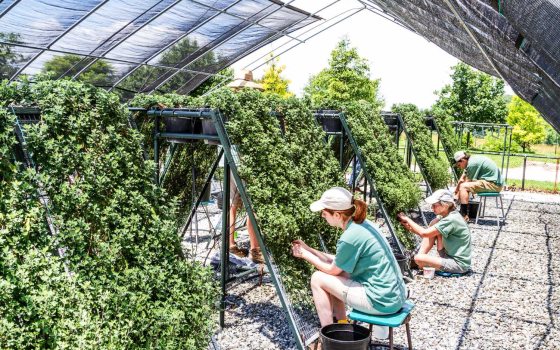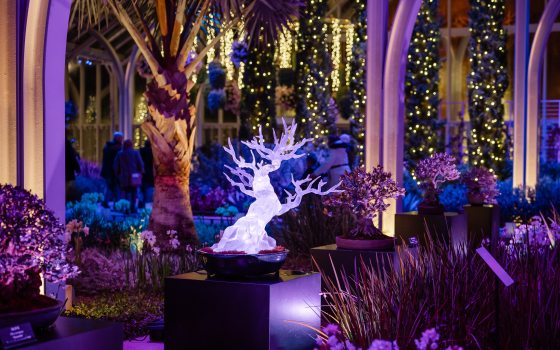Renowned for its rare cultivars and imaginative forms, our Chrysanthemum Festival is the majestic embodiment of our unwavering dedication to preserving the time-honored technique and culture of mum-growing. We take more than a year to prepare for each Chrysanthemum Festival, growing and nurturing all of the large, specialty chrysanthemums both indoors and out, which raises some unique challenges—especially when Mother Nature doesn’t seem to cooperate.
Before they take the form of clouds, columns, and more, our cascade chrysanthemums—used for our forms because of their flexibility and ability to grow lengthy stems—start in our production greenhouses as stock plants. We take cuttings from those stock plants each December prior to Chrysanthemum Festival, and the cuttings remain in the greenhouses until the last of that year’s frost before we move them outdoors in May, once natural daylight lasts longer than 12 hours per day. We move them outdoors as we don’t have the space to grow all of the cascade chrysanthemums indoors. “While they’re indoors, we focus on growing them to their desired length under controlled conditions,” shares Senior Grower Jason Simpson, who oversees the cascade chrysanthemum program. “Once they’re moved outdoors, that control goes out the window and we work with Mother Nature.”

Did we ever have to work with Mother Nature this year. We always account for weather conditions, but this summer proved to be an especially rainy one—including one August morning when we experienced more than 2 inches of rain in less than 3 hours—and a season in which we had to take added measures to keep our chrysanthemums healthy and thriving, despite challenging conditions. If chrysanthemums become overwatered, they can lose their required fertilizer and be susceptible to nutrient deficiencies and diseases. We experienced so much rainfall that our horticulture team had to intermittently cover the root ball of each chrysanthemum with plastic in order to dry out each plant and help keep the root systems disease-free.
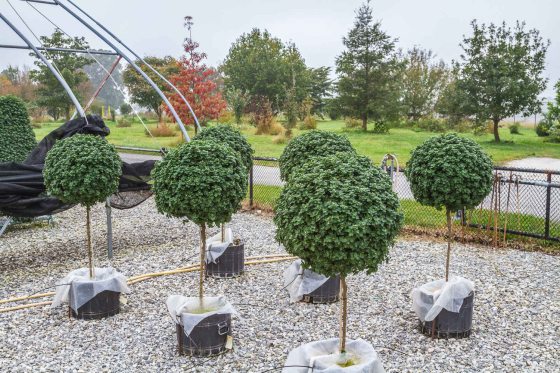
On top of the summer’s heavy rainfall, we also found ourselves contending with our fair share of heat. Our horticulture team uses shade cloths to keep our chrysanthemums cool and thriving, especially when temperatures reach the 90s. When temperatures climb, chrysanthemums are more prone to disease problems and can go into survival mode, rather than continue healthy growth.
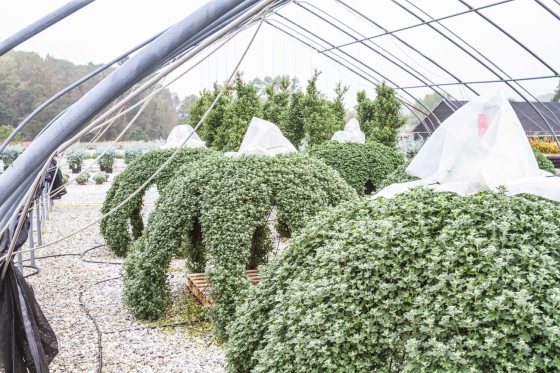
No matter the outdoor conditions we must face, our horticulture team keeps a constant eye on each and every cascade chrysanthemum. From the time they’re moved outside in May until they’re put on display in our Conservatory in October, the team runs a weekly soil test to make sure pH and electrical conductivity—influenced by salts from the fertilizer—are at an optimal level. “Mums are a tough plant by nature,” shares Simpson. “But we help them along and grow them to be even stronger.” The team hand-pinches and shears the plants to create multiple buds and multiple flowers per stem. The cascade chrysanthemums typically grow 2 to 4 inches per week, and each pinch creates two more new stems, resulting in a fuller plant and more future flower buds. We allow the flower buds to form starting in early September. Each resulting form takes a different length of time to achieve its required size.
The hard work has paid off. Our inventive Chrysanthemum Festival display is vibrant, beautiful, and, quite simply, amazing. Our Thousand Bloom Mum—the largest mum in North America with 1,437 blooms on one stem—shines bright and our new traditional fan form delights. Spanning seven feet, the fan includes the white ‘Yamanoha-no-Kumo’ cultivar along the majority of its surface area, surrounding a striking red ‘Kurume’ circle in the center of the fan, and accented by a custom bamboo handle made here at Longwood. Influenced by a Longwood staff visit to Sorakuen, a public garden in Kobe City, Japan, the fan ultimately symbolizes the Japanese flag, the origin of chrysanthemum display, and the sheer talent and perseverance of our horticultural staff. With a little help from Mother Nature, too.
